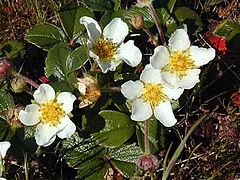| Revision as of 21:07, 31 January 2006 editGdrbot (talk | contribs)45,158 editsm nomialbot — converted multi-template taxobox to {{Taxobox}}← Previous edit | Revision as of 02:15, 15 February 2006 edit undoDr U (talk | contribs)Extended confirmed users3,563 edits changing imageNext edit → | ||
| Line 2: | Line 2: | ||
| | color = lightgreen | | color = lightgreen | ||
| | name = Beach Strawberry | | name = Beach Strawberry | ||
| | image = |
| image = Fragariachileonsis.jpg | ||
| | image_width = 240px | | image_width = 240px | ||
| | image_caption = <small>''Fragaria chiloensis''</small> | | image_caption = <small>''Fragaria chiloensis''</small> | ||
Revision as of 02:15, 15 February 2006
| Beach Strawberry | |
|---|---|

| |
| Fragaria chiloensis | |
| Scientific classification | |
| Kingdom: | Plantae |
| Division: | Magnoliophyta |
| Class: | Magnoliopsida |
| Order: | Rosales |
| Family: | Rosaceae |
| Subfamily: | Rosoideae |
| Genus: | Fragaria |
| Species: | F. chiloensis |
| Binomial name | |
| Fragaria chiloensis (L.) Duchesne | |
The Beach Strawberry or Chilean Strawberry (Fragaria chiloensis) is one of two species of strawberry that were hybridized to create the modern Garden Strawberry. It is noted for its large berries. Its natural range is the Pacific Ocean coasts of North and South America, and also Hawaii.
It is still sold as a local delicacy in some South American produce markets.
Subspecies
There are a number of subspecies and forms:
- Fragaria chiloensis subsp. chiloensis forma chiloensis
- Fragaria chiloensis subsp. chiloensis forma patagonica
- Fragaria chiloensis subsp. lucida
- Fragaria chiloensis subsp. pacifica
- Fragaria chiloensis subsp. sandwicensis
Polyploidy
All strawberries have a base haploid count of 7 chromosomes. Fragaria chiloensis is octoploid, having eight sets of these chromosomes for a total of 56. These eight genomes pair as four distinct sets, of two different types, with little or no pairing between sets. The genome composition of the octoploid strawberry species has generally been indicated as AAA'A'BBB'B'. The A-type genomes were likely contributed by diploid ancestors related to Fragaria vesca or similar species, while the B-type genomes seem to descend from a close relative of Fragaria iinumae. The exact process of hybridization and speciation which resulted in the octoploid species is still unknown, but it appears that the genome compositions of both Fragaria chiloensis and Fragaria virginiana (and by extension the cultivated octoploid strawberry as well) are identical.
External link
This fruit-related article is a stub. You can help Misplaced Pages by expanding it. |